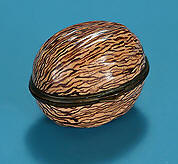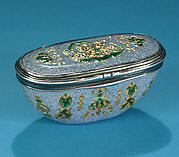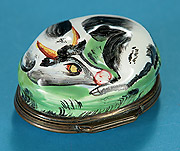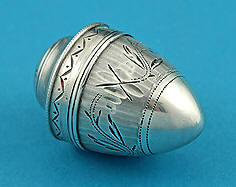M. FORD CREECH ANTIQUES
& FINE ARTS
GOOD SOUTH STAFFORDSHIRE ENAMEL BONBONNIERE
England, c1765-70
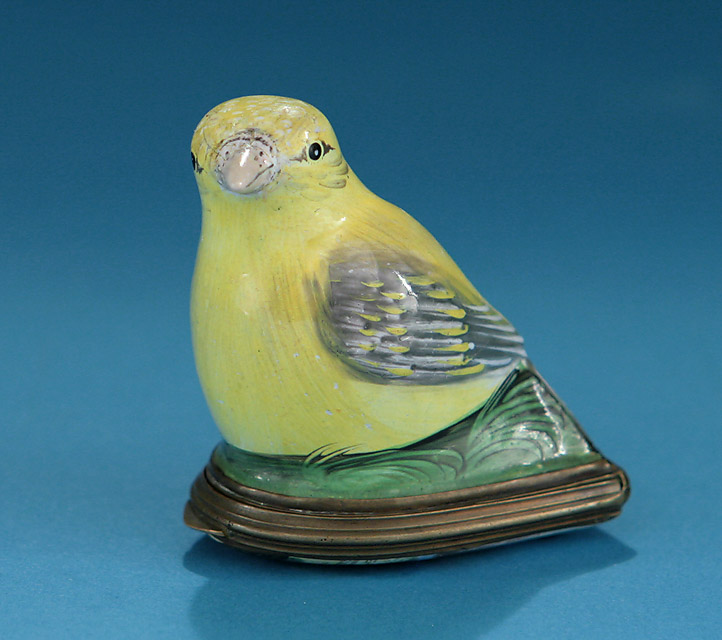
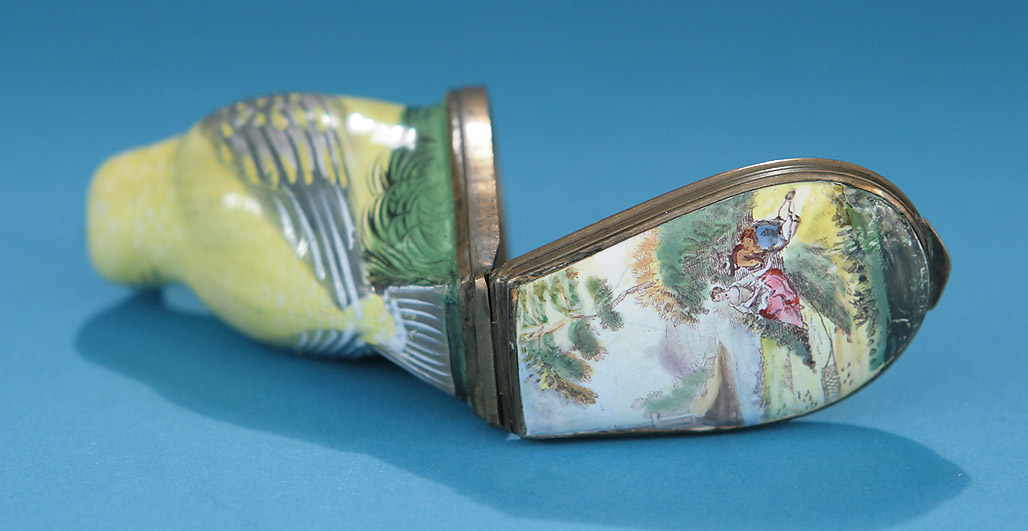
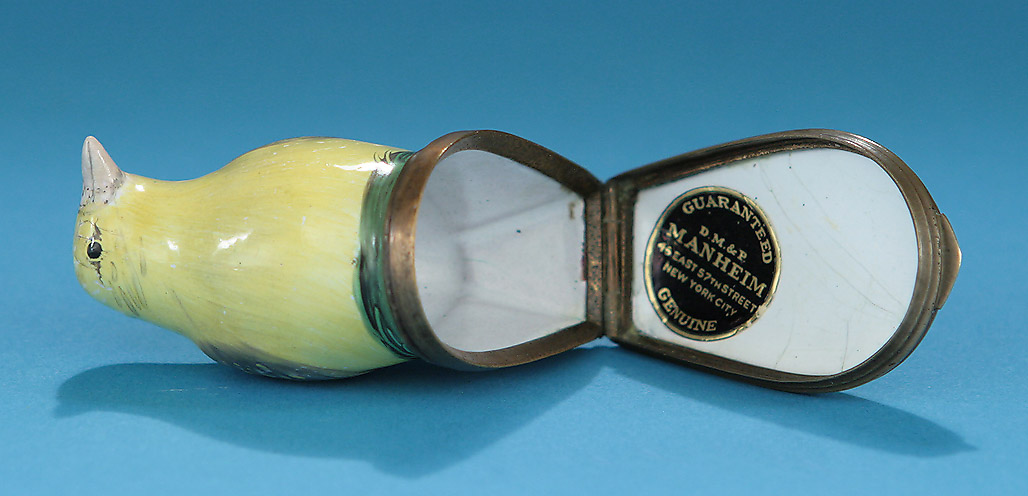
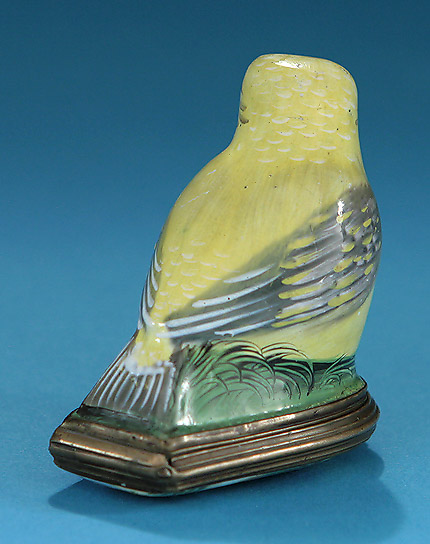
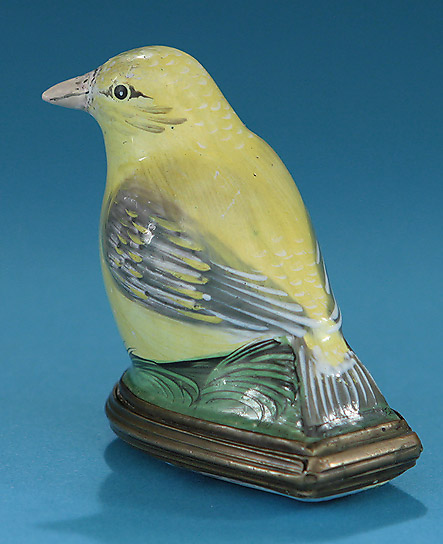
The small enamel on copper box with a yellow canary atop a grassy mound, opening to a white enameled interior,
the verso painted with a huntsman and a lady* beneath a tree in a landscape before river and ruins
Provenance : Manheim, NYC, bearing old label
Ref : Two similar bird models, with differently painted plumage, are illustrated by Therle and Bernard Hughes,
English Painted Enamels (1951), pl .
* The "huntsman and lady" theme, painted on the lid verso, also appears on an important opaque white glass
flask in the Schreiber Collection, illustrated by R J Charleston, 'Petitions for Patents', ECC Trans, Vol 6, 1966,
plate 69 (c, d). Although unable to trace the exact source, he also relates the decoration to the Birmingham area.
Condition : Very good, with a few small areas of very well done restoration, including the tip end of the beak
and the lower right of the verso lid painting; several minor expected scratches, minor cracks and painting flakes;
probable repair to the copper edging surrounding enamel verso
2"High x 2"Long x 1.25"Deep
sold
#6230
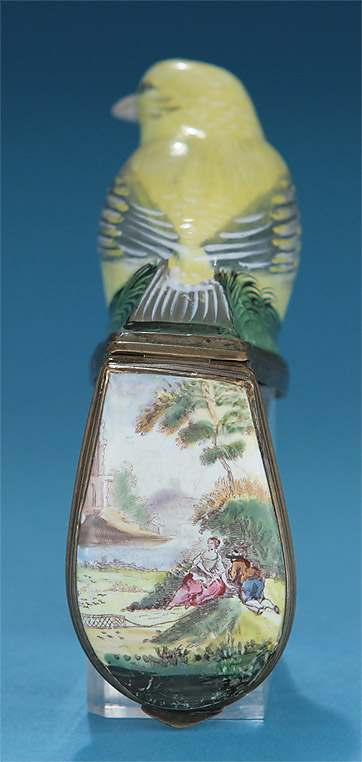
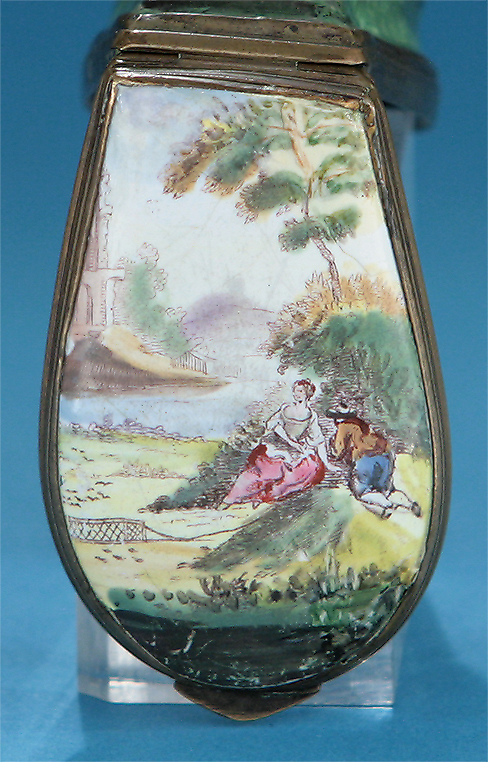
|
Most are familiar with snuff boxes. Sniffing snuff was the original method of taking tobacco, first used by the American Indians, the substance being brought back to Europe by Christopher Columbus on his second voyage (1494-96) to the New World. It was immediately popular among the Spanish and French, and brought into England with the return of Charles II in 1660. It was a substance for the aristocrat, and particularly popular in court circles. All ladies in Queen Anne's court followed her passion of snuff-taking, and Queen Charlotte (wife of George III) was known as "Snuffy Charlotte", due to her very frequent use. Her son, George IV, changed his snuff according to the time of day, and had a storage room set aside in each of his palaces for his boxes.
However, unlike snuff, I am often asked about bonbonnieres, and the purpose of these quite small boxes. The earliest bonbonnieres can be traced back more than 300 years - popular first on the Continent, and introduced into Scotland by the time of Mary Queen of Scot's (an extension of the interchange between France and Scotland at that time). Amongst wealthy aristocrats, small boxes of sweets - each holding only a few confections - were given to celebrate birthdays, christenings, and marriages. The earliest sweets would have been dry and rather hard confections known as "comfits" (sugared nuts, cloves and seeds) and diamond form sugar "lozenges". In the 17th and 18th centuries, sugar was quite costly - even its shipment having to come by boat from the faraway Caribbean islands. Thus so were the containers costly - sometimes made of gold, precious stones, crystals, or porcelain. Actually, even owning a bonbonniere indicated a person as one of wealth
In Italy, bonbonnieres were traditionally given as wedding gifts, each enclosing five sugared almonds, representing fertility, health, wealth, happiness and longevity, as well as the bittersweet life of a married couple. Further, in the 18th century, everyone had very "bad breath". The sugar-coated seeds and nuts contained in bonbonnieres were sucked to disguise this fault.
Bonbonnieres were generally made in enamel on metal, in porcelain with metal mounts, and some exquisite and very expensive examples in gold. A Russian jeweled and enameled gold bonbonniere by Fabergé sold at Christies in 2006 for $411,864.00. There are also a few in silver. Some glass examples are also known - but rare due to their fragility. The concepts for these boxes are often quite whimsical and intricate. Some are set with small portraits or landscapes and precious stones - most particularly the gold examples. The English were particularly good at fashioning whimsical animal forms in enamel on copper.
Bonbonniere prices range from several hundred dollars for a simple wooden example, to 6 figures for boxes of jeweled gold. |
Also See :
|
South Staffordshire Enamel on Copper England, c1765 |
18th cContinental Silver-Mounted Enamel Snuff Box In the Manner of Julian Berthe |
South Staffordshire Enamel on Copper Bonbonniere England, c1765 |
|
For more silver boxes & objects of vertu, please click below :
http://www.mfordcreech.com/silver.html#SILVER_BOXES
|
We welcome and encourage all inquiries. We will make every attempt to answer any questions you might have.
For information, call (901) 761-1163 or (901) 827-4668, or
Email : mfcreech@bellsouth.net or mfordcreech@gmail.com
American Express, Mastercard, Visa and Discover accepted
M. Ford Creech Antiques & Fine Arts / 581 South Perkins Road / Memphis, TN 38117 / USA / Wed.-Sat. 11-6, or by appointment
|
Accessories Ceramics Early Asian Ceramics Fine Art Furniture Glassware Silver Home
Good South Staffordshire
Bird-Form Enamel Bonbonniere, England c1765 |
